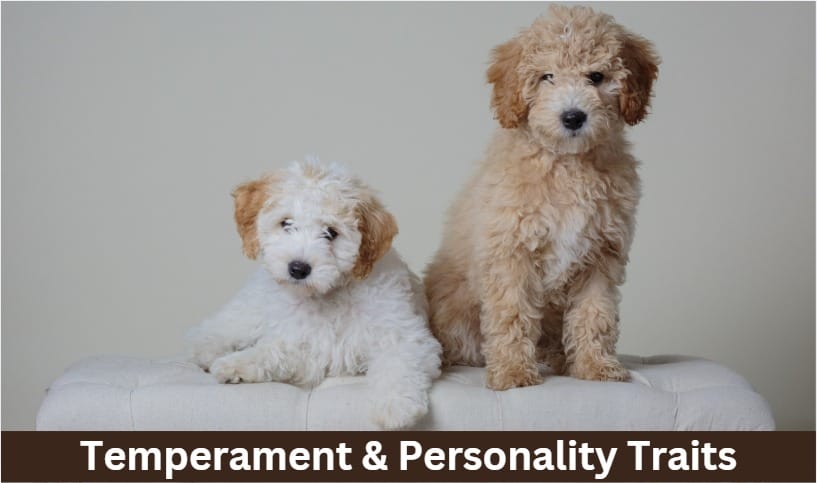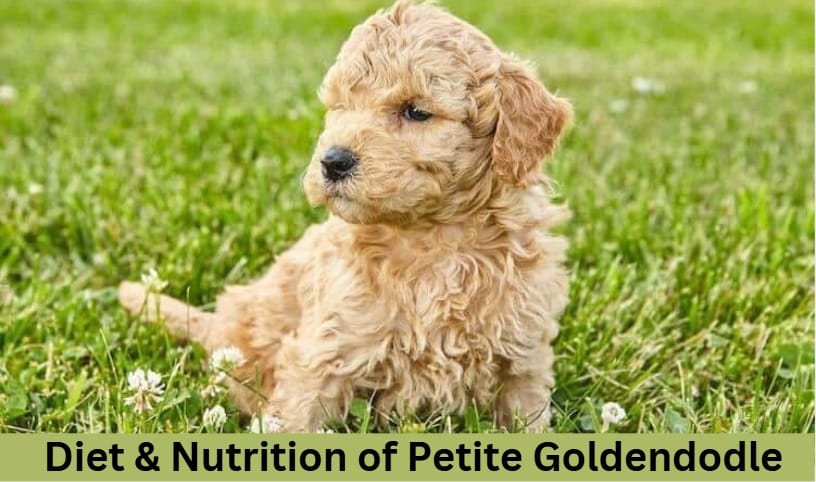
Looking for a fluffy, friendly companion that fits into small spaces and busy families? Meet the Petite Goldendoodle! These adorable hybrids mix the smarts of Mini Poodles, the charm of Golden Retrievers, and sometimes a dash of Cocker Spaniel. Perfect for apartments, allergy sufferers, and first-time owners, this guide covers everything from size to training and fun quirks. Let’s dive in!
Petite Goldendoodle: At a Glance
| Category | Details | Best For | Considerations |
|---|---|---|---|
| Size | 12-20″, 15-35 lbs | Apartments, small homes | Not fragile but compact |
| Temperament | Friendly, intelligent, affectionate | Families, seniors, first-time owners | Prone to separation anxiety |
| Coat Types | Curly (least shed), wavy, straight | Allergy sufferers* | Requires 2-3x weekly brushing |
| Exercise Needs | 30-60 mins/day (walks + play) | Active owners | Can become bored if under-stimulated |
| Trainability | Highly trainable (Poodle intelligence) | Novice owners | Responds best to positive reinforcement |
| Health | Lifespan: 10-15 years | Owners committed to vet care | Risk of hip dysplasia, ear infections |
| Grooming | Professional grooming every 8-12 weeks | Those willing to invest time/money | High-maintenance coats |
| Cost | $1,500−$3,500 upfront + $80−$150/month | Budget-conscious buyers | Grooming/vet costs add up |
What is a Petite Goldendoodle?
Though the American Kennel Club (AKC) does not classify them as an official breed, families and apartment dwellers increasingly seek these dogs as compact, low-shedding companions. People sometimes use terms like micro mini Goldendoodle or teacup Goldendoodle for clarity, but reputable breeders avoid these labels to prevent unrealistic size expectations.
Origin & History
- Developed in the 1990s as a smaller, allergy-friendly alternative to Standard Goldendoodles.
- Mixes Golden Retriever (friendly), Mini Poodle (hypoallergenic), and sometimes Cocker Spaniel (compact size).
- Gained popularity due to their adaptability and “teddy bear” looks.
Why Were They Bred?
- Hypoallergenic coats: Shed less, ideal for allergy sufferers.
- Small size: Perfect for apartments, city living, or families with kids.
- Companionship: Social, loyal, and eager to please.
Why Are They So Popular?
- Celebrities and social media influencers showcase them as trendy pets.
- Designer dog craze: Combines the best traits of parent breeds.
- Their Instagram-worthy looks (hello, #DoodleFame!).
Petite Goldendoodle Size, Weight & Appearance

How Big Do Petite Goldendoodles Get?
Petite Goldendoodles are the smallest in the doodle family, bred for compact living. While not an official breed category, these tiny pups typically stand 12–20 inches tall and weigh 15–35 lbs when full-grown—smaller than Standard or Mini Goldendoodles. Their size varies depending on genetics, but they’re ideal for apartments, travel, or snuggle sessions on the couch!
| Type | Height | Weight |
|---|---|---|
| Petite Goldendoodle | 12–20 inches | 15–35 lbs |
| Mini Goldendoodle | 15–20 inches | 25–35 lbs |
| Standard Goldendoodle | 20–24 inches | 50–90 lbs |
- Full-grown petite Goldendoodles stay compact, making them ideal for small homes.
- Goldendoodle sizes make them easy to travel with—they’ll curl up on your lap during car rides!
- Unlike larger breeds, they don’t need a backyard but thrive with daily walks and playtime.
Coat Types & Colors
- Coat Types: Curly (Poodle-like), wavy, or straight.
- Colors: Apricot, cream, red, black, or parti-colored (multi-colored patches).
- Pro Tip: Curly coats shed less but need more grooming!
Hypoallergenic Traits – Do They Shed?
- Low-shedding: Great for allergies, but no dog is 100% hypoallergenic.
- Regular brushing (2–3 times a week) reduces dander and matting.
Temperament & Personality Traits

Are Petite Goldendoodles Good Family Dogs?
- ✅ Yes! Gentle, patient, and playful with kids.
- ✅ Great with seniors, other pets, and even cats (with proper socialization).
- ❌ Can develop separation anxiety if left alone too long.
Intelligence & Trainability
- Ranked among the smartest doodle breeds (thanks to Poodle genes!).
- Training Tips: Use positive reinforcement (treats, praise, playtime).
- Avoid harsh methods—they’re sensitive souls!
Separation Anxiety – Can They Be Left Alone?
- They love being around people—limit solo time to 4–6 hours max.
- Prevent Anxiety: Use puzzle toys, crate training, and gradual alone-time practice.
Training & Socialization
How to Train a Petite Goldendoodle?
- Best Methods: Clicker training, short sessions (10–15 mins), and consistency.
- Start training early—puppies as young as 8 weeks can learn basics!
- Housebreaking: Take them outside every 2–3 hours and reward success.
- Use phrases like “go potty” to create a routine.
Common Behavior Issues & Solutions
- Jumping: Ignore until calm, then reward.
- Teach “off” by stepping back and rewarding when paws are on the floor.
- Barking: Redirect with a toy or command like “quiet.”
- Identify triggers (e.g., doorbells) and desensitize them.
- Chewing: Provide durable toys like Kongs or Nyla bones.
- Puppies chew to soothe teething—freeze toys for extra relief!
Mental Stimulation & Preventing Boredom
- Puzzle Toys: Outward Hound puzzles, snuffle mats.
- Hide kibble in a rolled-up towel for a DIY challenge!
- Games: Hide-and-seek, fetch, or agility courses (indoors or outdoors).
- Rotate toys weekly to keep things exciting.
First 30 Days with a Petite Goldendoodle Puppy

Bringing Your Puppy Home – First Day Tips
- Create a cozy space with a bed, toys, and water.
- Let them explore slowly—avoid overwhelming them.
- Introduce family members one at a time to prevent stress.
Setting Up a Routine
- Feeding: 3–4 small meals daily for puppies.
- Stick to the same brand the breeder used initially.
- Sleeping: 18–20 hours of sleep a day (yes, puppies nap a lot!).
- Use a white noise machine to soothe nighttime jitters.
Crate Training & Housebreaking
- Crate Size: Just big enough to stand and turn around.
- Line it with a soft blanket and a chew toy.
- Potty Schedule: After meals, naps, and playtime. Reward outdoor potty trips!
- Accidents happen—clean with enzyme spray to remove odors.
Diet & Nutrition – What Should a Petite Goldendoodle Eat?

Best Dog Food Options
- Kibble: High-quality brands like Royal Canine or Hill’s Science Diet.
- Look for formulas with real meat as the first ingredient.
- Raw/Homemade: Consult a vet for balanced recipes.
- Avoid raw diets if your dog has a sensitive stomach
Portion Sizes & Feeding Schedule
| Age | Daily Food |
|---|---|
| Puppy (2–6 mo) | 1/2–1 cup (split into 3–4 meals) |
| Adult | 1–1.5 cups (split into 2 meals) |
- Adjust portions based on activity level—active dogs may need more!
Foods to Avoid
- Chocolate, grapes, onions, xylitol, and fatty meats.
- Human snacks like popcorn or chips can upset their stomach.
Grooming & Maintenance
Grooming Routine
- Brushing: 2–3 times a week to prevent mats.
- Use a slicker brush for curly coats and a comb for tangles.
- Bathing: Every 4–6 weeks with dog-safe shampoo.
- Dry thoroughly to avoid skin infections.
Nail, Ear, and Teeth Care
- Trim nails monthly to avoid overgrowth.
- If you hear clicking on floors, it’s time for a trim!
- Clean ears weekly to prevent infections (use vet-approved solution).
- Check for redness or odor—signs of an infection.
- Brush teeth 2–3 times a week with dog toothpaste.
Professional Grooming vs. DIY
- Pro Grooming: Every 8–12 weeks (50–50–100 per session).
- Ask for a “puppy cut” to keep their coat manageable.
- DIY Tips: Invest in clippers, brushes, and nail trimmers.
- Watch YouTube tutorials for breed-specific trims!
Health Concerns & Lifespan
While Petite Goldendoodles are generally healthy, they can inherit certain health issues from their parent breeds. The most common problems include hip dysplasia (a joint condition), ear infections (due to floppy ears trapping moisture), allergies (food or environmental), and eye issues like cataracts. Regular vet checkups help catch these early, especially since allergies often show up as itchy skin or recurring ear infections.
| Health Issue | Symptoms | Prevention/Treatment |
|---|---|---|
| Hip Dysplasia | Limping, discomfort | Regular vet check-ups, healthy diet |
| Progressive Retinal Atrophy (PRA) | Vision loss | Genetic screening, eye exams |
| Ear Infections | Head shaking, odor | Regular ear cleaning |
| Hypothyroidism | Weight gain, lethargy | Medication, vet supervision |
| Allergies | Itchy skin, ear infections | Specialized diet, vet guidance |
Pro Tip: Pet insurance can ease the cost of unexpected vet bills! 🩺
Lifespan
- 10–15 years with proper care.
- Keep them lean to avoid joint stress—extra pounds shorten lifespans!
Preventive Care
- Annual vet checkups, vaccinations, and flea/tick prevention.
- Pet insurance can offset unexpected costs (plans start at $30/month).
Senior Petite Goldendoodle Care – How Their Needs Change with Age
Aging Health Problems
- Arthritis, vision loss, and dental issues.
- Provide orthopedic beds for joint support.
- Cognitive decline: Nighttime pacing or confusion.
Diet Adjustments for Senior Petite Goldendoodles
As your Petite Goldendoodle ages, their dietary needs change to support their slowing metabolism and joint health. Switch to senior-specific dog food formulated with glucosamine and chondroitin to cushion aging joints and ease arthritis discomfort. Adding fiber-rich ingredients like pumpkin or vet-approved supplements can also aid digestion and prevent constipation, keeping their tummy happy and healthy.
Joint Supplements
- Vet-recommended options: Dasuquin, fish oil, or CBD treats.
- Gentle exercise like swimming keeps joints mobile.
Exercise & Activity Requirements
Daily Exercise Needs for Petite Goldendoodles
Petite Goldendoodles need 30–60 minutes of daily activity to stay fit and happy—think brisk walks, fetch sessions, or brain-teasing puzzle games. Split this into morning and evening sessions to fit busy schedules while keeping their energy balanced. Regular exercise prevents boredom and supports their playful, curious nature! 🐕💨
Best Activities
- Fetch, agility training, or scent games.
- Set up a mini obstacle course in your living room!
Apartment Living Tips
- Indoor play: Stair runs, tug-of-war, or treat puzzles.
- Use a long leash at parks for safe off-leash fun.
Ethical Breeding & What to Look for in a Breeder

Choosing a Reputable Breeder
Always ask breeders for health clearances—like hip evaluations, eye exams, and DNA tests—to ensure your puppy’s parents are free of genetic issues. Meeting the puppy’s mom (and dad, if possible) lets you observe their temperament, giving clues about your future pup’s personality. A trustworthy breeder will welcome questions, provide proof of ethical practices, and prioritize the dogs’ well-being over quick sales. 🐾
Red Flags
- Puppy mills, no health guarantees, or rushed sales.
- Breeders who won’t answer questions about the litter’s history.
Petite Goldendoodle Breeder Directory
Looking for a healthy, ethical Petite Goldendoodle? Here are our top-vetted breeders:
Top Breeders in the US
- Sunshine Doodles (Florida)
- Specializes: Miniature Goldendoodles (15-25 lbs).
- Health Testing: OFA-certified hips, DNA-tested for PRA.
- Website: sunshinedoodles.com
- Tiny Paws Doodles (Texas)
- Specializes: Toy Petite Goldendoodles (10-15 lbs).
- Reviews: 4.9/5 stars on Google.
- Website: tinypawsdoodles.com
Petite Goldendoodle vs. Mini Goldendoodle
| Trait | Petite Goldendoodle | Mini Goldendoodle |
|---|---|---|
| Size | 12–20 inches | 15–20 inches |
| Weight | 15–35 lbs | 25–35 lbs |
| Ideal For | Apartments, seniors | Active families |
| Energy Level | Moderate | High |
Cost of Owning a Petite Goldendoodle
| Expense | Average Cost |
|---|---|
| Puppy Price | $1,500–$3,500 |
| Adoption Fee | $300–$800 |
| Monthly Costs | $80–$150 (food, grooming) |
| Annual Vet Care | $300–$600 |
Budget Tip: Invest in training classes early to avoid costly behavior issues later!
Traveling with a Petite Goldendoodle
- Airline Travel: Small enough to fly in-cabin (check airline weight limits).
- Book early—only a few pets are allowed per flight.
- Car Safety: Use a crash-tested harness or carrier.
- Stop every 2–3 hours for potty breaks on road trips.
Common Myths & Misconceptions
- Myth: They’re 100% hypoallergenic.
Truth: Low-shedding ≠ allergy-free. Saliva and dander can still trigger reactions. - Myth: Small dogs need less exercise.
Truth: They’re energetic! Daily play is a must to prevent boredom.
Real Owner Reviews & Experiences
- Pros: Loving, adaptable, great with kids.
- “My Petite Goldendoodle is my shadow—always by my side!” – Sarah, NY
- Cons: Prone to barking, grooming costs add up.
- “Invest in a good vacuum—their hair sticks to everything!” – Mark, TX
Fun Facts & Trivia
- Some have “phantom” markings (like eyebrows!) from their Cocker Spaniel lineage.
- TikTok star @DoodleDaisy has 1M followers for her Petite Goldendoodle antics!
- They’re known to “talk” with grumbles and whines to communicate.
Final Thoughts
Petite Goldendoodles are the ultimate package for anyone seeking a playful, adaptable, and affectionate companion. Their compact size makes them ideal for apartment dwellers or families in cozy homes, while their low-shedding coats (though not 100% hypoallergenic) are a lifesaver for allergy sufferers. Whether you’re a first-time dog owner, a busy parent, or a retiree looking for a loyal sidekick, these doodles thrive in nearly any lifestyle—as long as they get daily love, mental stimulation, and cuddles! Their Golden Retriever charm and Poodle smarts create a dog that’s eager to please, easy to train, and endlessly entertaining.
From viral Instagram moments to quiet nights on the couch, Petite Goldendoodles bring joy to every corner of life. Ready to join the #PetiteGoldendoodle fan club? 🐾 Don’t forget to share your doodle’s adventures online—their goofy antics and teddy bear looks are bound to steal hearts!
P.S. If you’re still on the fence, connect with local Petite Goldendoodle owners or rescue groups. Meeting these pups in person might just convince you to bring one home! 🏡💕
Frequently Asked Questions (FAQs)
Q: What’s the smallest size petite Goldendoodle?
The smallest Petite Goldendoodles typically weigh 15–20 lbs and stand 12–14 inches tall.
Q: Where can I find a Petite Goldendoodle breeder near me?
Search AKC Marketplace, local breed clubs, or vet-recommended breeders; avoid puppy mills.
Q: What’s the lifespan of the Petite Goldendoodle?
10–15 years with proper diet, exercise, and vet care.
Q: Are there health issues with Petite Goldendoodles?
Common issues include hip dysplasia, ear infections, allergies, and eye problems.
Q: Are Petite Goldendoodles non-shedding?
They shed minimally (curly coats shed least) but aren’t fully non-shedding.
Q: Are petite Goldendoodles hypoallergenic?
They’re hypoallergenic-friendly (low dander) but no dog is 100% allergy-proof.
Q: Do Petite Goldendoodles bark a lot?
They bark occasionally but respond well to training; boredom or anxiety may trigger noise.
Q: Do breeders do Puppy Culture with Petite Goldendoodles?
Ethical breeders often use Puppy Culture for early socialization—ask about their practices
Q: Can I get an 8-week-old Petite Goldendoodle?
Yes, reputable breeders send puppies home at 8–12 weeks after weaning and socialization.





Leave a Reply